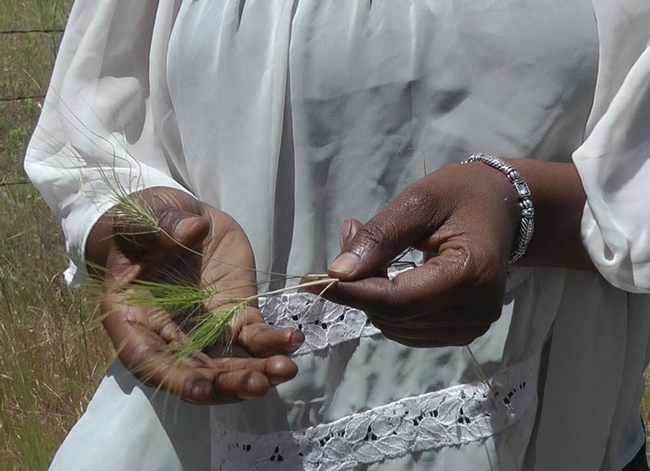
Medusahead, an unwelcome transplant from Europe, is anathema to the cattle living off rangeland grass. The weed's three-inch-long bristles poke and sometimes injure the animals' mouths and eyes. The weed is also low-quality forage for livestock. When medusahead takes over rangeland, it reduces the forage value by 80 percent.
When Fadzayi Mashiri, UC Cooperative Extension advisor in Mariposa, Merced and Madera counties, was appointed in 2013, she became the first natural resources and rangeland expert to hold the position since the retirement of Wain Johnson more than a decade before. She polled local ranchers to determine their most pressing problems. They said weed management, and in particular, medusahead.
Medusahead is relatively easy to identify on the range. It has distinctive stiff awns and a seed head that does not break apart as seeds mature. Patches of medusahead are obvious when spring turns into summer.
“Medusahead stays green after most of the annual grasses have dried off,” Mashiri said.
Medusahead has high silica content, making it unpalatable to cattle. The silica also protects the plant from decomposition, so a thick thatch builds up on the rangeland, suppressing more desirable species, but not the germination of the next year's medusahead seedlings.

- Corral cows on medusahead before the plant heads out or employ sheep to graze medusahead patches. It's not sheep's favorite forage either, but they will eat if left with no other option.
- Prescribed burning in late spring or early summer. However, this strategy poses air quality and liability issues.
- Apply nitrogen fertilizer to medusahead to improve palatability before it flowers, which is showing promise for controlling the weed and boosting the value of infested rangeland.
- Chemical control.
In spring 2014, Mashiri conducted a demonstration field trial in Mariposa County of medusahead control with the herbicide Milestone, which was developed by Dow AgroSciences mainly to control broadleaf weeds like yellow starthistle. The trial followed rangeland weed control research done by scientists including Joe DiTomaso, UC Cooperative Extension specialist in the Department of Plant Sciences at UC Davis. DiTamaso found that the density of medusahead in treated areas declined and concluded that Milestone prevents medusahead seedlings from thriving.
Unfortunately, Milestone treatment of large rangeland areas is expensive.
“But if the value of forage declines, the productivity of livestock is compromised,” Mashiri said. “When you look at it that way, the chemical treatment might be useful.”